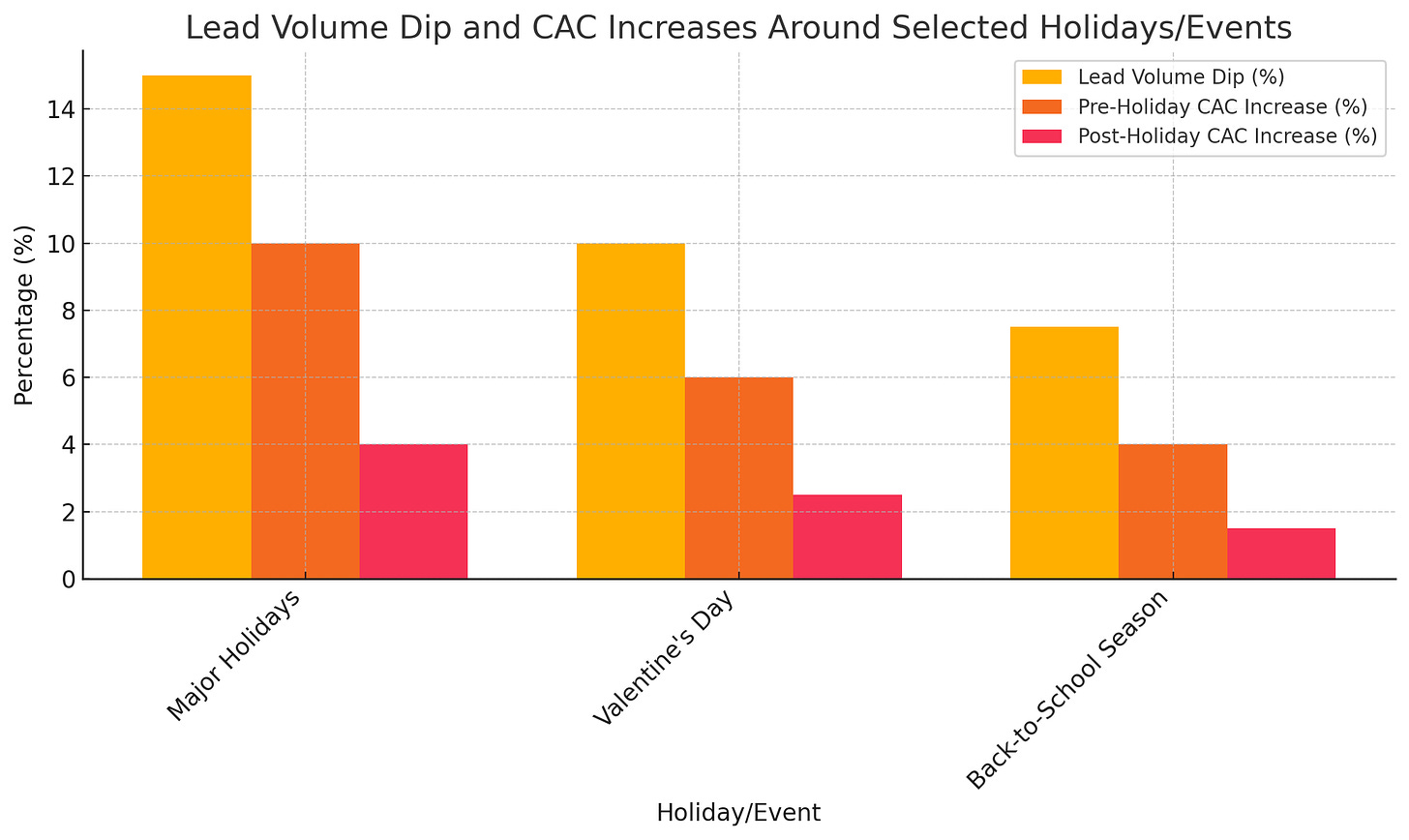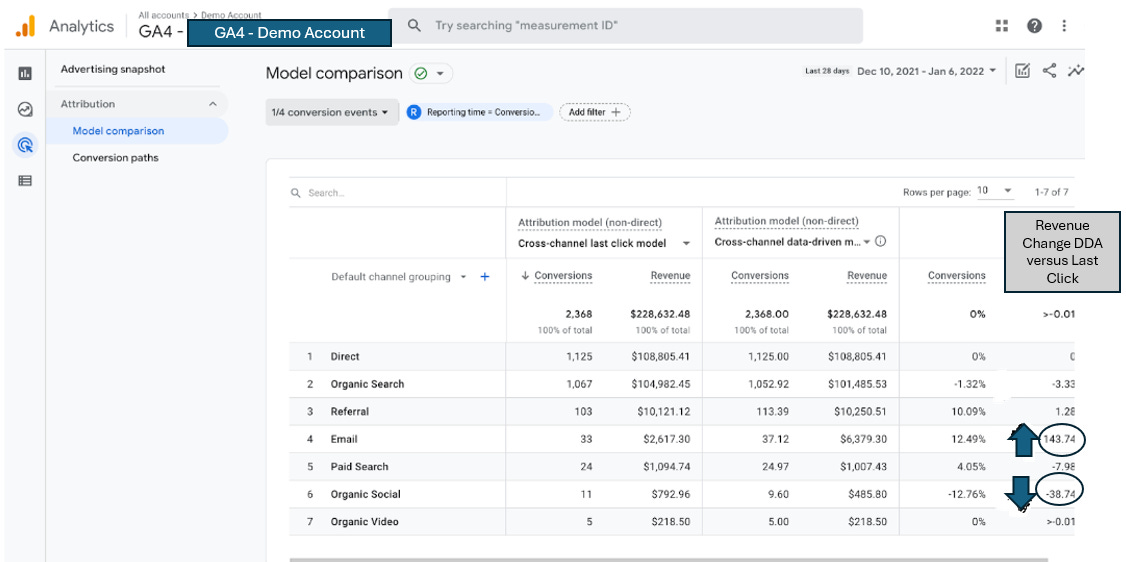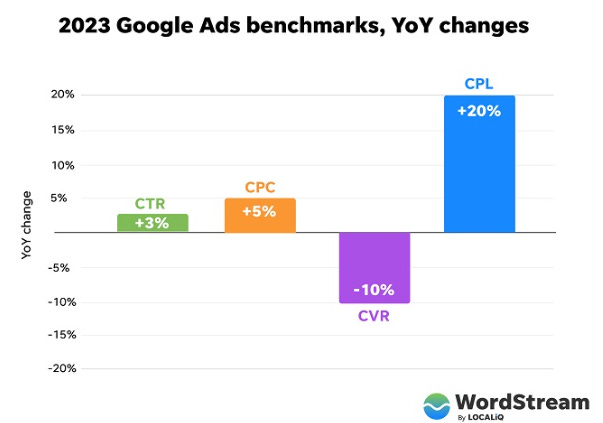High CAC Got You Down? Join the Club! A Lighthearted Take on Growth Marketing Hurdles
Time for some self deprecating humor and a good laugh 😅. As growth marketers, we're no strangers to the rollercoaster ride that is customer acquisition cost (CAC). I've definitely had my share of high CAC and at times, I have been at my wits end where the drivers are not clear, and I have offered squishy (but true !) reasons..
Below are 5 most common squishy (but true !) reasons. I also provide the strategic move-forwards that have helped me break the logjam in those cases
1. “Seasonality resulting in higher CAC with no good way to forecast; it happens every year “
Move Forward: Go back 5 years (or whatever timeframe possible) and create a historic demand and CAC curve around national holidays, and events.
Around most holidays, the typical dip in lead volume for most products/services is ~10% with ~5-7% higher overall CAC
Most of the leads lost are regained in the subsequent week with a slightly elevated overall CAC. Holiday season is a different ballgame altogether. Demand for goods is higher leading to higher bids and CAC has been higher by as much as 15-20% . Have your custom analysis baked into the projections/forecasts. Below is a more directional quantitative read on lead volume/CAC changes around specific events/holidays:
Detailed Table
Condensed bar chart
Armed with seasonality data, I have been in a much better position to forecast, and then explain the spikes.
2. “Analytics isn’t crediting sales to all the marketing touchpoint”
Sigh… Here comes the attribution grinch again..
Accurately attributing sales to various marketing touchpoints is a perennial challenge for marketers. The “attribution grinch” often complicates this task, but understanding and utilizing the right models can help.
TL;DR Cross-channel rule-based attribution, such as linear and time decay models, provides simplicity but often lacks nuance. Last-Click credits the final touchpoint before conversion, undervaluing earlier interactions.
Move Forward:
Use Data-Driven attribution, the GA4 default for the most accurate view to capture missing and comprehensive sales/revenues from marketing touchpoints
Data-Driven Attribution (DDA), the default in GA4, uses an algorithm to distribute credit across touchpoints based on historical data and AI modeling, analyzing over 50 touchpoints for a comprehensive view. DDA has been a life saver for me and almost always captures sales and revenues from marketing touchpoints that would be missing from any of the other methodologies..
But why is DDA Superior ?
There are several challenges these days leading to a portion of conversions being unobservable or customer journeys being incomplete. Most common contributors for these are non-consent to cookie collection, multi-device customer journeys, and iOS device limitations further impacting the ability to observe and track conversions. DDA analyzes trends between directly observed conversions and those that are unattributed, thereby getting the bigger picture…
By identifying similarities between attributed conversions on one browser and unattributed conversions on another, it predicts overall aggregated attribution including any potentially missing conversions.
Game Changer - See the last column that shows difference in revenue at a channel level when using DDA over Last Click. This leads to a different conclusion and more nuanced set of actions compared to scenario where only Last Click is used
GA4 - DDA versus Last Click
Final point - There is a Caveat since DDA doesn’t handle Offline channels
For online/offline mix, use Media Mix Modeling used to estimate the impact of various marketing tactics on sales and other key performance indicators. It uses regression analysis, to determine the relationship between marketing inputs (advertising spend, promotions, etc.) and desired outputs (sales, website visits, app downloads). The model isolates the impact of each marketing channel, revealing which ones drive the most significant results. As a downside, it is complex to build with at least 18 months of data needed across various channels.
Use Longer horizon-Use Media Mix Modeling to integrate online and offline data through regression analysis, estimating the impact of various marketing tactics on sales and other KPIs.
3. “We're still optimizing our targeting; it's a work in progress."
While optimizing messaging and positioning is an ongoing process, a persistently high CAC demands more than just tweaking ad copy.
Move Forward: It's time to take a step back and re-evaluate your targeting strategy. Are you casting too wide a net ?
Go back to basics and refine your Ideal Customer Profile (ICP). Delve into the demographics, behaviors, and pain points of your most valuable customers. 2-3 well-defined ICPs strikes the right balance between reach and impact - Remember. Quality over quantity
In one of the studies, HubSpot shared that companies targeting 1-2 ICPs experience a 15% increase in deal close rates compared to those pursuing a wider range of profiles.
Creating ICP
ICP creation is a multi-faceted process that goes far beyond demographics and firmographics.
First, start with data - analyze your existing customer base, identifying those who generate the highest lifetime value. Look for patterns in their demographics (age, location, income), firmographics (industry, company size), and behavioral data (purchase history, website interactions).
Start with data and focus on the segment with highest lifetime value. Most analysts prefer K-means clustering techniques given the simplicity and efficiencies
K-means works most of the time if you have a general idea on how many segments you will find. Alternately, if you don’t want to pre-define the number of clusters, hierarchical clustering can be used but it is relatively complex and computationally expensive for large datasets.
Then, conduct in-depth interviews with these high-value customers to gain qualitative insights into their challenges, goals, and decision-making processes.
Don’t just stick with Yes/No questions. Ask open-ended questions to uncover their pain points and how your product or service addresses them.
This provides a wealth of qualitative insights that can't be captured through quantitative data alone. By asking open-ended questions about their pain points, challenges, and desires, you uncover the underlying motivations that drive their purchasing decisions. This deep understanding enables you to tailor your messaging
4. “The market is currently oversaturated, which is driving up the cost of advertising”
Move forward: This is a bit complex and the move forward is a combination of all of the below
FIND cost-effective ways to reach same audience WHILE maximizing the return on EXISTING ad spend
Cost-effective ways - Direct Mail, Organic and others
Direct mail, often overlooked in the digital age, can be a powerful weapon in a growth marketer's arsenal. By reaching customers in their physical space, it offers a tangible, personalized touchpoint that cuts through the digital clutter. In industries like financial services, where precision targeting is crucial, direct mail shines with its ability to reach specific demographics at surprisingly low CACs. But it's not just about credit cards and loans – even discount-driven sectors like retail and travel can reap the benefits of direct mail's high response rates and memorable impact.
Investigate, and if you find your audience is there, don't dismiss direct mail – embrace it as a valuable channel for driving growth and conversions….
Organic: Organic reach holds a pivotal role in shaping the long-term success of any business. It's the backbone of sustainable growth, as opposed to the fleeting benefits of paid promotions. To build a robust organic presence, businesses must invest in SEO to ensure their content is discoverable by search engines. Additionally, active engagement on social media and other community platforms is crucial. Participating in conversations, responding to comments, and listening to your audience's needs humanizes your brand and strengthens customer relationships.
By harmonizing SEO, content marketing, and community engagement, businesses can create a synergistic effect and the holistic approach not only drives traffic and engagement but also builds a loyal customer base, ensuring long-term success.
Maximizing returns from existing activities
In my prior article, I wrote about the optimizing existing ad spend
As upfront channel level cost-pers from performance channel rise, it will be essential to ensure that funnel/journey conversion rate gets better to compensate for the deficit. Conversion rate optimization is the key to improving CACs and gaining that ROI edge. CAC pressures are real, but they are manageable with a focused and strategic approach. Another mitigation tactic is relentless focus on enhancing organic presence.
5. “External Factors we don’t control have lowered demand”
In one of my prior jobs - within a week of pandemic, US decides to put Student Loan payments on hold. Our flagship product was Student Loan refinancing and a stroke of the pen, our TAM was cut in half
Move forward: Proactively keep looking beyond the core offerings for product or segment adjacencies to expand the TAM. Expand your product line to cater to your existing customers' broader needs. This not only opens new revenue streams but also strengthens customer loyalty.
In the prior example, when student loan refinancing tanked, we pivoted to a personal line of credit that compensated for the loss of TAM from that segment. Subsequently, we added more use cases to the product to expand TAM further.
Your flagship product might be taking a hit, but that doesn't mean your entire business needs to suffer. Always keep looking beyond the core offerings for product or segment adjacencies to expand the TAM.
Another example - Faced with plummeting demand during the pandemic, the travel industry showcased remarkable resilience through innovative pivots and adjacencies. Airlines transformed into cargo carriers, capitalizing on the surge in e-commerce shipments…
That concludes my top 5 reasons. Would love to hear everyone’s thoughts.
What are some of the squishy (but true !) reasons have you offered when CAC goes through the roof? Let's laugh at ourselves a bit and learn from each other's experiences! 😄






